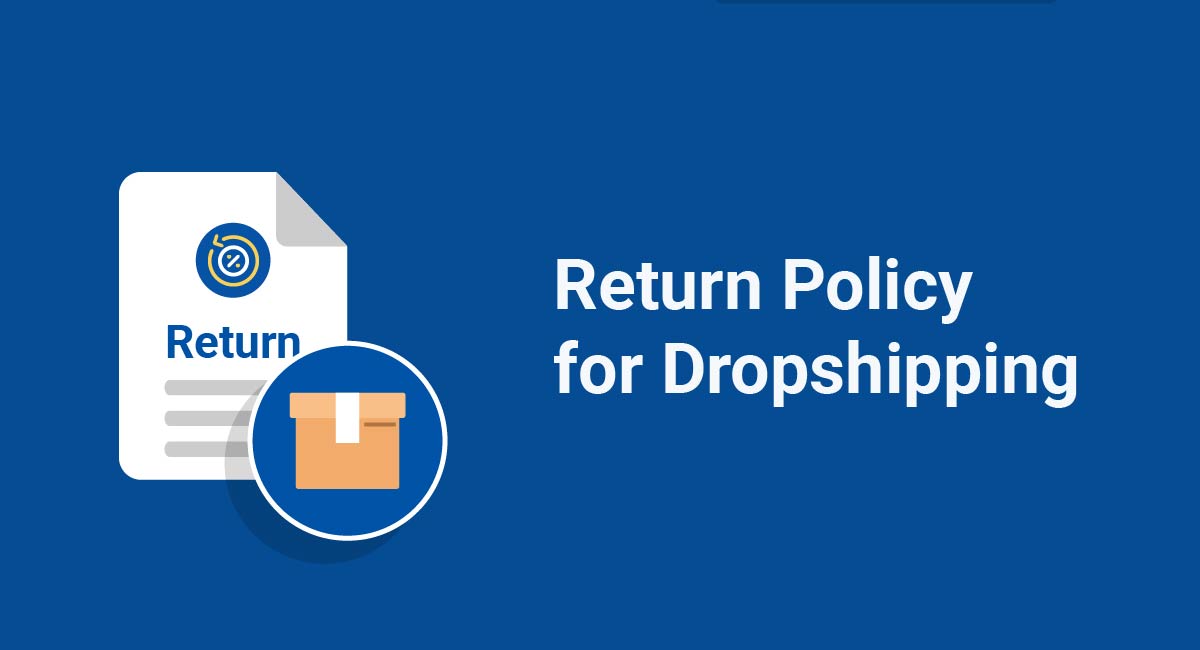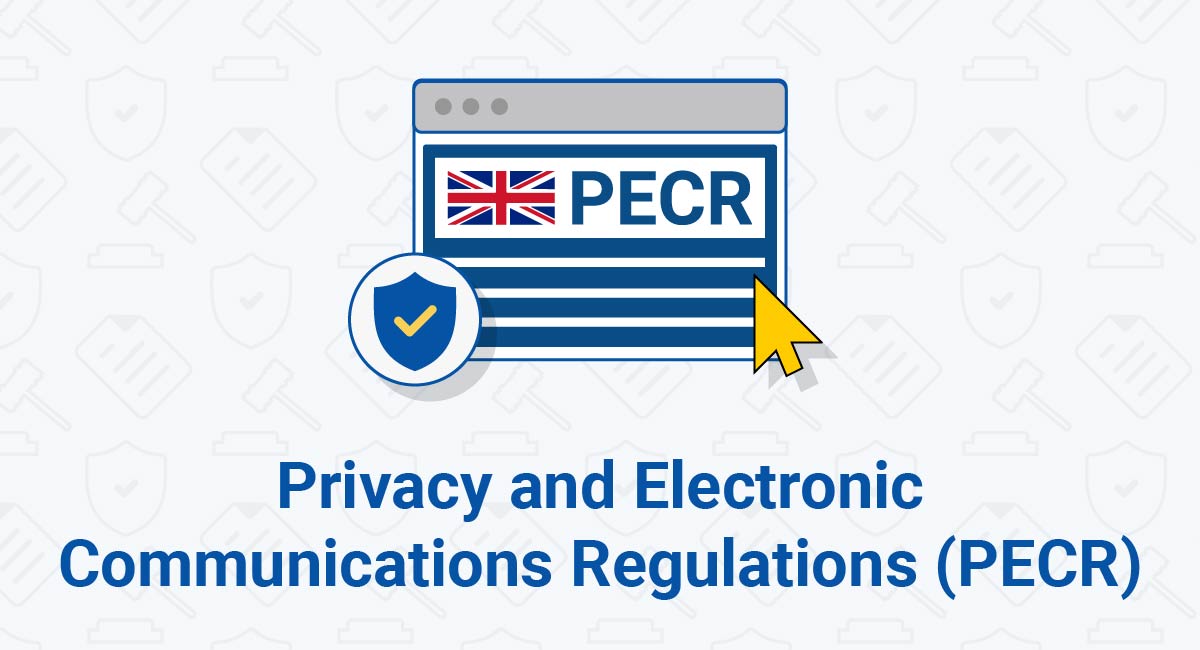Many dropshippers overlook a critical aspect of store creation when setting up their businesses. Namely, they often overlook the need for having a Return Policy.
Having a Return Policy will help you streamline your ecommerce processes while boosting your site's professionalism. Shoppers also tend to select places with clear return policy information in place versus ones that don't disclose this upfront or in a convenient way.
This article will look at what a Return Policy is, why you should have one, and how to create and display one for your dropshipping store.
Use our Return & Refund Policy Generator to generate a Return and Refund Policy for your store. Just follow these steps:
-
At Step 1, select where your Return & Refund Policy will be used.
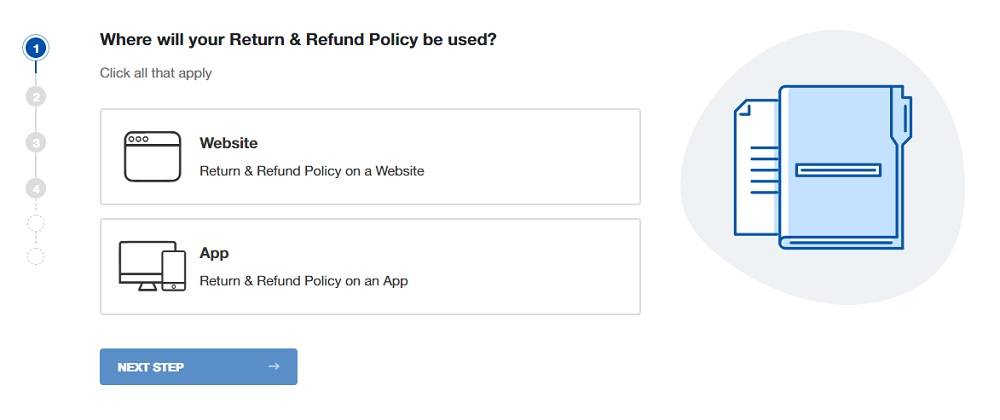
-
At Step 2, add information about your website/app and business.
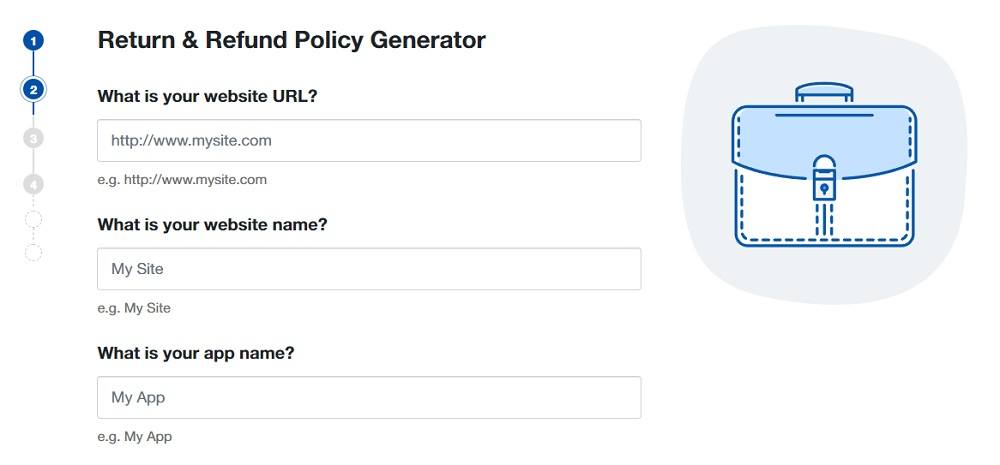
-
Answer some questions about your business practices.
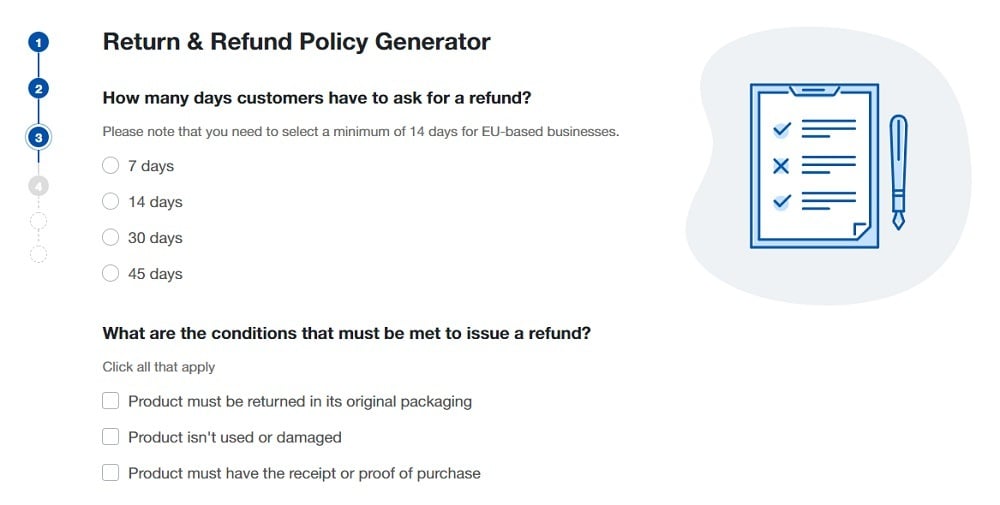
-
Enter an email address where you'd like to receive your Return and Refund Policy and click "Generate."
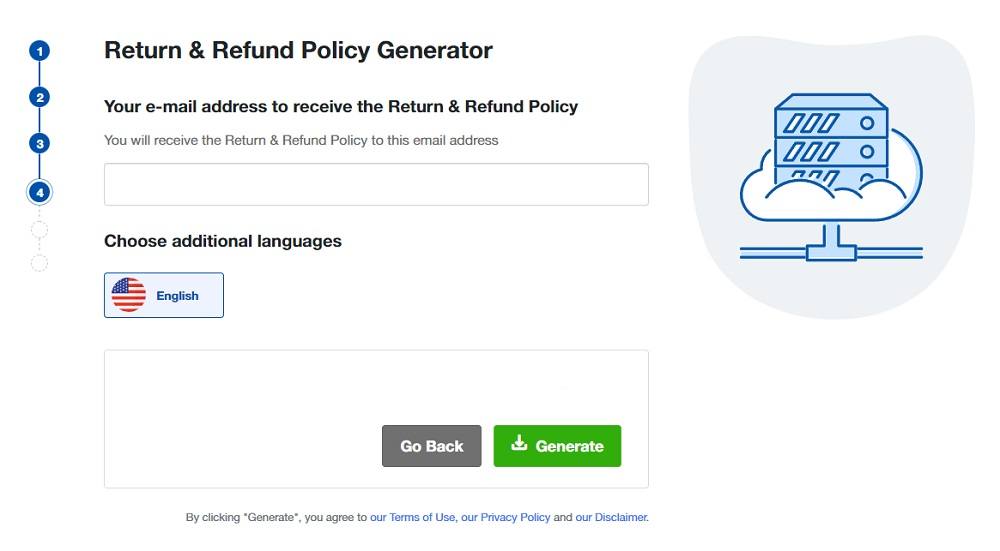
Done! You'll be able to instantly access and download your new Return and Refund Policy.
- 1. What is a Return Policy?
- 2. Why Should You Post a Return Policy?
- 3. What to Include in a Dropshipping Return Policy
- 3.1. Time Frame for Returns
- 3.2. Who Pays for Shipping
- 3.3. The Process for Initiating Returns
- 3.4. The Condition of Returned Items
- 3.5. Restrictions on Returns
- 3.6. Type of Refund Given
- 4. Where to Display Your Return Policy
- 5. Best Practices for Return Processes
- 6. Summary
What is a Return Policy?
A Return Policy is a policy that plainly outlines the scenarios and terms under which cancellations, returns, and refunds may occur.
Many customers will check a Return Policy agreement before making a purchase since it is a legally binding agreement between the buyer and seller. Remember, many SaaS, ecommerce, and dropshipping companies do not share the same policies regarding cancellations, returns, or refunds at all.
One may provide refunds during a specific time frame, while another may not give refunds under any circumstances. Where you stand as a dropshipper on these issues ought to be clearly laid out in a publicly posted Return Policy for the benefit of your company and its customers.
Specific issues to address within a proper Return Policy are the following:
- Countries eligible for returns and refunds
- Whether time limits exist for the return of items
- Whether your company offers replacements for returns
- Whether returns are free (i.e., do you pay for shipping on the return?)
- Whether there are items that customers are prohibited from returning
- How fast refunds are provided (i.e., how many business days it takes)
Here's an excerpt from a Return Policy:
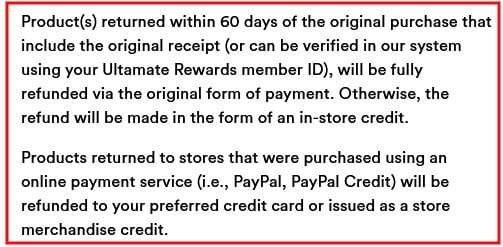
Why Should You Post a Return Policy?
A Return Policy provides that benefit in two primary ways:
- A clear Return Policy written in plain, everyday language that is publicly posted can boost the potential confidence customers have in doing business with your dropshipping company. The more confidence customers have, the more likely it is that they will do business with you, which in turn means an increase in sales.
- Since a Return Policy is a legal agreement, it allows you to control the circumstances under which you'll accept returns and make refunds.
It's important to note that some return and refund laws demand that you accept all returns during a specific time frame if you don't publicly post your own Return Policy.
What to Include in a Dropshipping Return Policy

Remember that your dropshipping Return Policy ought to be customer-centric. While you obviously don't want to harm your own interests, you want to build trust between your company and your customers.
The easier you make things for customers to trust you and be happy with their overall experience in doing business with you, the more likely they'll buy from you more than once.
Time Frame for Returns
Make sure to include a section in your Return Policy that stipulates how long customers have to return items. Make sure customers know precisely how long they have after receiving an item to let you know they intend to return it.
Here's how Best Choice Products lets its customers know this information in its Return Policy:

Additionally, a good Return Policy will let customers know what kind of refund you'll provide them, if any. For example, will you give them store credit? Will you provide them with a product similar to the one that was returned?
Meowington's, a dropshipping company inspired by one woman's unconditional love for cats, answers this question by allowing exchanges for returned items:

Who Pays for Shipping
You should also include a statement regarding who pays for the shipping on returns and under what circumstances.
As you can see in the following example, Pet Boutique places all of the financial responsibility for returns on its customers.

The Process for Initiating Returns
Different dropshipping companies obviously have different Return Policies. However, all of those that have policies are able to follow them because they have a process for cancellations, returns, and refunds in place.
Let users know what they need to do to actually make a return, and make it as streamlined and easy as possible:
Here's an example of a clause that lets users know what steps they need to take:
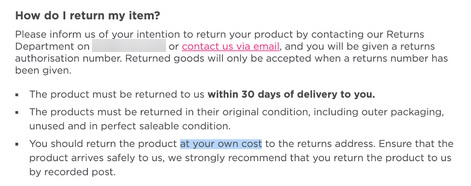
And here's one that's even more simple and straightforward, letting users know to contact the company:

The Condition of Returned Items
Some companies specify that a returned item must be in its original packaging and unopened. Others aren't quite as strict.
Here's an example of how you can outline the condition of returns:

Restrictions on Returns
Some dropshippers put restrictions on exactly what may and may not be returned. If you don't allow certain things to be returned, you should clearly spell this out in your Return Policy.
For example, here's an example of a clause that's very explicit about the types of returns that will not be accepted:

Type of Refund Given
It's also the right idea to spell out what kind of refund you'll provide to your customers. Some people want their money back, but others might be happy with an exchange for the same type of item or for another item with equal value.
You should take the time to make it perfectly clear what type of refund you'll provide your customers when a return takes place.
In the following example, the refund will go back on a customer's credit card:

While your Return Policy may need additional clauses depending on your industry, your personal business practices and what you personally desire to do with how you handle returns and refunds, the above sections are fairly standard and a great place for you to start with creating your Return Policy.
After you have your Return Policy written, it will be time to display it for your customers to find with ease. Here are some tips and tricks for that.
Where to Display Your Return Policy

Return Policies are like other legal agreements displayed on websites. They should always be displayed in a conspicuous, easily accessed area on your company's site.
One of the most common areas to display an Return Policy is in the footer, as seen here:
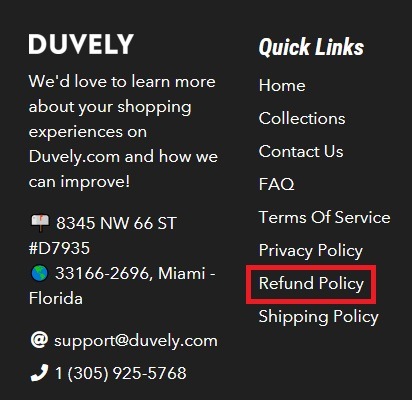
Often, you will see other agreements such as a Privacy Policy and a Terms and Conditions agreement in this area as well.
A best practice is to add a statement within your Terms and Conditions agreement that summarizes your Return Policy, provides a link to the full policy, or that at least references the other policy.
Here's how Best Choice Products does in its Terms agreement:

Other areas where you may wish to include links to your Return Policy are on the website chat and product, shopping cart, checkout, and FAQ pages. This will give your customers extra opportunities to take a look at your return policies before making up their minds about making a purchase.
Best Practices for Return Processes
When creating a process for returns, the following are best practices to follow:
- Ensure that your customers know about your Return Policy
- Let your dropshipping supplier know about the return
- Request a shipping label from your supplier and then send it to your customer
- Customers will have questions about the status of their return shipment, exchange, or refund. It's, therefore, a great idea to provide tracking. You can also automatically text them once you receive their return.
- Do not give your customer a refund until your dropshipping supplier has received the return and has issued you the refund first
Remember that you can take a lot of the frustration regarding returns out of the equation entirely by ensuring that label and shipping information is included in your Return Policy as well.
Summary
The bottom line is that how you manage returns to your dropshipping company hugely affects both customer loyalty and sales.
- Before making purchases, more than 60% of dropshipping customers review Return Policies.
- Only 49% of online retailers (dropshippers included) actually post a Return Policy on their websites.
- The vast majority of consumers expect return shipping to be free.
- As long as the return process is simple and hassle-free, up to 92% of consumers say they'll purchase from the same store again
Remember that making a purchase decision without ever interacting with someone real and without ever seeing or touching a product in person is a reality in today's online world of E-commerce.
The very nature of the business creates a certain amount of uncertainty. The fact that a clear and straightforward Return Policy helps to reduce insecurity on the part of the buyer makes it a necessity.
Keep in mind that:
- A Return Policy is a policy that plainly outlines the scenarios and terms under which cancellations, returns, and refunds may occur.
- A clearly written Return Policy helps increase trust and confidence in your company.
- An Return Policy allows you to control the circumstances under which you'll accept returns and make refunds.
- A proper Return Policy should be written in plain, easy to understand language.
- The Return Policy should be conspicuously displayed on your website in a common location, such as the footer.
You should always include important information within your Return Policy, such as:
- The time frame under which you will accept returns
- Who is financially responsible for the shipping of returns
- How customers may initiate the return process
- Requirements for the condition of returned items
- Whether there are restrictions on what type of items may be returned
- What kind of refund you provide in the event a return takes place
You cannot please everyone. As you work to grow your dropshipping business, it's almost a given that some customers are going to be unsatisfied with one aspect or another of doing business with you.
However, data shows that you're much more likely to find long-term success if you're able to craft a return and refund strategy that makes the entire process of cancellations, returns, exchanges, and refunds as painless as humanly possible.
Return Policies are a powerful tool which you can use to preemptively cut down on lousy customer experiences while simultaneously building trust and protecting your company.

Comprehensive compliance starts with a Privacy Policy.
Comply with the law with our agreements, policies, and consent banners. Everything is included.
